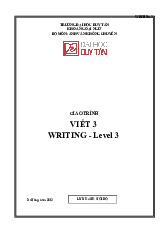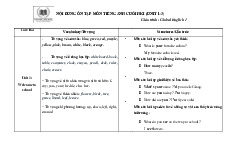





Preview text:
lOMoAR cPSD| 47028186 CSR and Brands
Brands today are often a focal point of corporate success and should be protected by integrating a
strategic CSR perspective throughout the firm. Companies try to establish popular brands in
consumers’ minds because it increases their competitive advantage. We have identified three
benefitsof CSR to brands: positive brand building, brand insurance, and crisis management.
Positive Brand Building
The Body Shop: Anita Roddick long championed the power of an influential global brand to enact
meaningful social change. In doing so, she helped distinguish her firm in the minds of consumers,
gaining a strategic advantage. Whether you agree with the stance that The Body Shop adopts on a
number of fair trade and other social issues,
53 many consumers are drawn to purchase the company’s products because of the positions it
takes. Its fair trade stance helps differentiate the firm’s offerings and stands out in the minds of
consumers. Similarly, Benetton has also set itself apart through advertising, using its voice to
comment on the social issues that it thinks are relevant to its consumers.
54 Ben & Jerry’s is another activist-alternative brand that pursues a similar strategy,
55 although its cult-like status has faded somewhat since the company was bought by Unilever in 2000. 56
BP: With a $200 million rebranding exercise, BP (the giant British Petroleum company) has
repositioned itself as the most environmentally and socially responsible of the integrated
petroleumcompanies. The firm stands in stark contrast to ExxonMobil, which faces ongoing
NGO attacks, consumer boycotts, and activist-led litigation because of its decision to oppose the environmental movement. 57
Shell has also done a good, if less high-profile, job
of rebranding itself in a similar way to BP, although it was lOMoAR cPSD| 47028186
tainted by a scandal concerning the reporting of proven oil reserves in 2004.
Positive brand building alone, however, is insufficient. A firm has to be genuine in its statements
and committed to implementing CSR throughout operations in order for the full benefits to be
realized. BP’s recent troubles in relation to CSR, such as lethal accidents at key U.S. refineries and
criticism about the extent of its investment in alternative energy sources, 58
have undermined the firm’s significant investment
in building a positive brand image. Brand Insurance 59
Nike: Today, this company is one of the most progressive global corporations in terms of CSR. We
argue that a significant reason for this is the firm’s past mistakes and attacks by NGOs that continue to this day.
60 Those attacks focused largely on the working conditions in Nike factories in Southeast
Asia, which, as Phil Knight, Nike’s founder and CEO, admitted, “produced considerable pain” for the firm in the late 1990s.
61 Although, initially, Nike was reluctant to reform, 62 lOMoAR cPSD| 47028186
today, the firm has become more proactive in arguing the positive impact of its operations and
products worldwide. Nike has created a vice president for corporate responsibility and publishes
CSR reports to institutionalize a commitment to CSR in its corporate structure and operations as
well as help protect the company’s brand against future CSR lapses. CSR Newsletters: Nike
It is characteristic of the media that good news takes a back seat to scandal, but this recent article
63 is worth highlighting as an example of how far Nike has come regarding CSR. The
article, buried deep in the sports pages of a local paper, reports Nike’s voluntary disclosure
of the mistreatment of workers at the factory of a Nike subcontractor in Malaysia:
including squalid living conditions, garnished wages and withheld passports of foreign workers.
Nike’s response is impressive:
Nike said all workers are being transferred to Nike-inspected and approved housing… All
workers will be reimbursed for any fees and going forward, the fees will be paid by the
factory. All workers will have immediate access to their passports and any worker who
wishes to return home will be provided return airfare.
Those executives that remain unconvinced of the value of CSR, however, are likely to remain
skeptical as long as such proactive behavior remains unrecognized, while the slightest
transgression is plastered all over the front pages.
Merck & Co.: Reflecting a socially responsible stance, George W. Merck, son of the
pharmaceutical company’s founder, announced, “Medicine is for the patients, not for the profits.” lOMoAR cPSD| 47028186
This radical corporate vision translates into an often cited example of the company donating the
medicine Mectizan to combat the devastating disease, river blindness: 64
Twenty-two years ago, Merck started giving away a drug to treat river blindness, a devastating
infectious disease endemic to certain countries in Africa and Latin America. The company has
donated 2.5 billion tablets at a total cost of $3.75 billion over that time. Merck manages the
program with the World Health Organization and other groups, and the effort is widely cited as a
model of successful public-private partnerships. [In 2009], WHO announced for the first time that
it sees evidence the disease will be eliminated in Africa with Merck’s drug. 65
It could be argued that Merck’s actions bought a degree of insurance against attacks by social
activists because of the company’s up-front commitment to such a worthwhile, unselfish, and
unprofitable cause. Perhaps this socially responsible viewpoint has enabled Merck to enjoy a
relatively free run from the activist criticism visited on other pharmaceutical companies. The
reputation it gained from this act has also been cited as a significant reason for the company’s success
in entering new markets, most notably Japan, where its socially responsible reputation preceded it.
Yet even Merck’s proactive CSR efforts may not save it from the economic and legal implications of
Vioxx, a Merck product voluntarily withdrawn from the market in 2004 after a growing number
of heart-related health problems among users. 66 lOMoAR cPSD| 47028186 Crisis Management
Johnson & Johnson: Johnson & Johnson’s transparent handling of the Tylenol crisis in 1982 is
widely heralded as the model case in the area of crisis management. J&J went beyond what had
previously been expected of corporations in such situations, instigating a $100 million recall of 31
million bottles of the drug following a suspected poisoning incident. In acting the way it did, J&J
saved the Tylenol brand, enabling it to remain a strong revenue earner for the company to this day:
The cost [of the re-call] was a high one. In addition to the impact on the company’s share price
when the crisis first hit, the lost production and destroyed goods as a result of the recall were
considerable. However, the company won praise for its quick and appropriate action…. Within
five months of the disaster, the company had recovered 70% of its market share for the drug. The
fact this went on to improve over time showed that the company had succeeded in preserving the
long-term value of the brand. Companies such as Perrier, who had been criticised for less adept
handling of a crisis, found their reputation damaged for as long as five years after an incident. In
fact, there is some evidence that it was rewarded by consumers who were so reassured by the
steps taken that they switched from other painkillers to Tylenol. 67
Brand value is critical to firms, whether on the local or global stage. Today, the value of the
intangible brand may even exceed the value of the firm’s tangible assets. The Coca-Cola brand,
for example, is worth significantly more than half of the company’s total market capitalization. 68 And lOMoAR cPSD| 47028186
CSR is important to brands within a globalizing world because of the way brands are built: on
perceptions, ideals, and concepts that usually appeal to higher values. CSR is a means of matching
corporate operations with stakeholder values at a time when these values are constantly evolving.
Thus, given the large amount of time, money, and effort companies invest in creating them, a good
CSR policy has become a vital component of a successful corporate brand—an effective means of
maximizing its market appeal while protecting the firm’s investment over the long term.
Companies today need to build a watertight brand with respect to all stakeholders. The
attractiveness of a company—whether as an employer, producer, buyer, supplier, or investment —is
directly linked to the strength of its brand. CSR affects all aspects of operations within a
corporation because of the need to consider the needs of constituent groups. Each area builds on
all the others to create a composite image of the corporation and its brand in the eyes of its stakeholder groups, which has great value for the firm.




